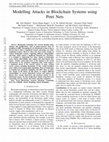Papers by Md Atik Shahriar

Computing, Apr 13, 2023
The know your customer (KYC) guidelines in financial services require that institutions make an e... more The know your customer (KYC) guidelines in financial services require that institutions make an effort to verify the identity, suitability, and assess risks involved while maintaining a business relationship. The procedures fit within the broader scope of any financial institution's Anti-Money Laundering (AML) policy. Governments around the world have digitalised this process to make it more convenient and transparent by introducing the notion of e-KYC (Electronic KYC). e-KYC provides a flexibility for the users as they might even quickly complete the on-boarding process from the comfort of their homes. However, there are a few outstanding issues, such as the lack of any global standardisation, possible fraudulent activities during the e-KYC process and other privacy concerns, that must be addressed before its full benefits can be achieved. Recently, blockchain technology (or blockchain in short) has emerged as a foundational technology with possibilities to disrupt a wide range of application domains. Understandably, it is increasingly being investigated how blockchain can be a useful tool to address these outstanding issues. Towards this aim, a number of research works have emerged in the recent years. In this article, we present a systematic literature review (SLR) of these works using the PRISMA model in order to identify and critically analyse the existing researches at the intersection of e-KYC and blockchain. Based on our study we have also identified the limitations of the existing solutions and provided future directions.

2020 IEEE 19th International Conference on Trust, Security and Privacy in Computing and Communications (TrustCom), 2020
Blockchain technology has evolved through many changes and modifications, such as smart-contracts... more Blockchain technology has evolved through many changes and modifications, such as smart-contracts since its inception in 2008. The popularity of a blockchain system is due to the fact that it offers a significant security advantage over other traditional systems. However, there have been many attacks in various blockchain systems, exploiting different vulnerabilities and bugs, which caused a significant financial loss. Therefore, it is essential to understand how these attacks in blockchain occur, which vulnerabilities they exploit, and what threats they expose. Another concerning issue in this domain is the recent advancement in the quantum computing field, which imposes a significant threat to the security aspects of many existing secure systems, including blockchain, as they would invalidate many widely-used cryptographic algorithms. Thus, it is important to examine how quantum computing will affect these or other new attacks in the future. In this paper, we explore different vulnerabilities in current blockchain systems and analyse the threats that various theoretical and practical attacks in the blockchain expose. We then model those attacks using Petri nets concerning current systems and future quantum computers.











Uploads
Papers by Md Atik Shahriar